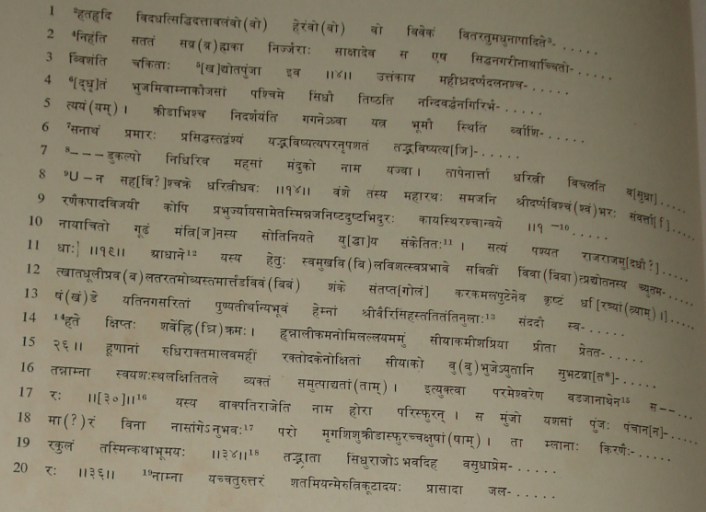|
The Indian Analyst
|
North Indian Inscriptions |
INSCRIPTIONS OF THE PARAMARAS OF BHINMAL BHINMAL STONE INSCRIPTION OF THE TIME OF JAYATSIṀHA
No. 95 ; PLATE XCI ...THIS inscription was transcribed and translated, in 1896, by A.M.T. Jackson, I.C.S., in the Bombay Gazetteer, Volume I, Part I. (1896) p. 474 (No. vi), and its date was noted by Dr. Kielhorn in his List of Inscriptions, published in the Epigraphia Indica, Volume V, appx. (No. 696). It was also referred to in P.R.A.S., W.C., 1907-08, p. 38. It is edited here from a fresh impression which I owe to the kindness of the Superintending Archaeologist of the Western Circle, Baroda. ... Jackson found the record ‘on the upper face of the eight-sided section of a fallen pillar on the south sidfe of the dome of the temple of Jagavāmī’, which is evidently a corrupt form of Jagat-svāmī (the Sun), at the town of Bhīnmāl in the Jālōr District of western Rājasthān. Some time subsequently, the pillar was set in a dharma-śālā, to the north-west of a Śiva temple now locally known as of Chandīśa-Mahādēva, where it exists to-day. The inscribed portion measures 19cms. Wide by 24.5 cms. high, and contains ten lines of writing.
... The alphabet belongs to the twelfth century, but the letters were neither carefully formed nor deeply engraved ; and now they are so highly weather-worn that a number of them have to be made out from the traces left and from the context. At three places (in 11. 3. 4 and 7) I had to restore some of them from Jackson’s reading. Their average size varies from 2 to 2.5 cms.
...The language is Sanskrit ; and the inscription is entirely in prose, showing inaccuracies
concerning language and the technical execution. With reference to orthography, the only perculiarities that call for notice are :- the use of the sign of the avagraha in 1. 7 and of an anusvāra which is wrongly put for a final m in the end.
[1] Originally ये engraved, later on changed to र्ये.
|
||||||||||||||||||||||||||||||||||||||||||||||||||||||||||||||||||||||||||||||||||||
| > |
|
>
|








